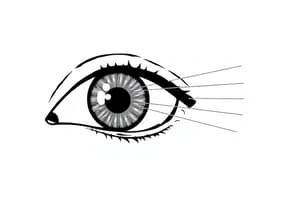Podcast
Questions and Answers
What is the primary role of the lens in the eye?
What is the primary role of the lens in the eye?
- Regulate the amount of light entering the eye
- Focus light onto the retina (correct)
- Control eye movement
- Convert light into neural signals
Which term describes the response of photoreceptors to varying light conditions?
Which term describes the response of photoreceptors to varying light conditions?
- Accomodation (correct)
- Contrast sensitivity
- Color adaptation
- Luminance adjustment
What is the effect of the pupillary reflex?
What is the effect of the pupillary reflex?
- It decreases the light entering the eye (correct)
- It increases the size of the lens
- It alters the shape of the retina
- It enhances color perception
Which of the following is NOT a central aspect of vision?
Which of the following is NOT a central aspect of vision?
What role do photoreceptors play in the eye?
What role do photoreceptors play in the eye?
What role does light play according to the information provided?
What role does light play according to the information provided?
Which process occurs in the retina to create an image?
Which process occurs in the retina to create an image?
How does the retina process distance information?
How does the retina process distance information?
What is transported to the brain after an image is formed in the retina?
What is transported to the brain after an image is formed in the retina?
What triggers the formation of an impulse in the retina?
What triggers the formation of an impulse in the retina?
What is the primary function of the cornea in the eye?
What is the primary function of the cornea in the eye?
Which structure is NOT one of the two main components responsible for light refraction in the eye?
Which structure is NOT one of the two main components responsible for light refraction in the eye?
What is the secondary structure that works alongside the cornea to refract light?
What is the secondary structure that works alongside the cornea to refract light?
What role does the lens play in the eye?
What role does the lens play in the eye?
What does the cornea's surface primarily contribute to in the eye?
What does the cornea's surface primarily contribute to in the eye?
What phenomenon describes the relationship between the contraction and relaxation of eye muscles?
What phenomenon describes the relationship between the contraction and relaxation of eye muscles?
Which of the following animals is mentioned as having the ability to perceive infrared light?
Which of the following animals is mentioned as having the ability to perceive infrared light?
What type of radiation do some animals use to perceive their prey's presence?
What type of radiation do some animals use to perceive their prey's presence?
What is the primary content of infrared light that distinguishes it from visible light?
What is the primary content of infrared light that distinguishes it from visible light?
In terms of visual processing, what distinguishes the visual fields of rabbits from humans?
In terms of visual processing, what distinguishes the visual fields of rabbits from humans?
What occurs when the parasympathetic system is activated in relation to pupil control?
What occurs when the parasympathetic system is activated in relation to pupil control?
Which muscle fibers are stimulated during sympathetic activation of the pupil?
Which muscle fibers are stimulated during sympathetic activation of the pupil?
What is the physiological term for pupil dilation?
What is the physiological term for pupil dilation?
Which of the following is NOT a result of parasympathetic stimulation of the pupil?
Which of the following is NOT a result of parasympathetic stimulation of the pupil?
Which reflex involves the control of pupil size in response to light?
Which reflex involves the control of pupil size in response to light?
What happens when the ciliary muscles are contracted?
What happens when the ciliary muscles are contracted?
Which type of feedback controls lens accommodation?
Which type of feedback controls lens accommodation?
How does the ciliary muscle's relaxation affect the lens?
How does the ciliary muscle's relaxation affect the lens?
What is the primary issue associated with presbyopia?
What is the primary issue associated with presbyopia?
What optical condition is characterized by different curvatures on the corneal surface?
What optical condition is characterized by different curvatures on the corneal surface?
What changes occur in the lens to see distant objects?
What changes occur in the lens to see distant objects?
What happens to the focal point during hyperopia?
What happens to the focal point during hyperopia?
When do the suspensory ligaments become tense?
When do the suspensory ligaments become tense?
Flashcards
Eye
Eye
The organ responsible for sight.
Photoreceptor
Photoreceptor
Cells in the eye that detect light.
Accommodation (eye)
Accommodation (eye)
The eye's ability to adjust focus for different distances.
Pupil reflex
Pupil reflex
Signup and view all the flashcards
Vision problems
Vision problems
Signup and view all the flashcards
Light-induced retinal changes
Light-induced retinal changes
Signup and view all the flashcards
Distance perception
Distance perception
Signup and view all the flashcards
Photoreceptor function
Photoreceptor function
Signup and view all the flashcards
Image formation in the eye
Image formation in the eye
Signup and view all the flashcards
Nerve impulse transmission
Nerve impulse transmission
Signup and view all the flashcards
Eye muscles
Eye muscles
Signup and view all the flashcards
Reciprocal action
Reciprocal action
Signup and view all the flashcards
Visual field
Visual field
Signup and view all the flashcards
Infrared light
Infrared light
Signup and view all the flashcards
Infrared receptors (animals)
Infrared receptors (animals)
Signup and view all the flashcards
Lens
Lens
Signup and view all the flashcards
Cornea
Cornea
Signup and view all the flashcards
Light-bending structures
Light-bending structures
Signup and view all the flashcards
Lens nutrition
Lens nutrition
Signup and view all the flashcards
Eye Light-bending
Eye Light-bending
Signup and view all the flashcards
Pupil size control
Pupil size control
Signup and view all the flashcards
Parasympathetic effect on pupil
Parasympathetic effect on pupil
Signup and view all the flashcards
Sympathetic effect on pupil
Sympathetic effect on pupil
Signup and view all the flashcards
Myosis
Myosis
Signup and view all the flashcards
Midriasis
Midriasis
Signup and view all the flashcards
Accommodation
Accommodation
Signup and view all the flashcards
Ciliary Muscles
Ciliary Muscles
Signup and view all the flashcards
Suspensory Ligaments
Suspensory Ligaments
Signup and view all the flashcards
Near Vision
Near Vision
Signup and view all the flashcards
Far Vision
Far Vision
Signup and view all the flashcards
Myopia
Myopia
Signup and view all the flashcards
Presbyopia
Presbyopia
Signup and view all the flashcards
Astigmatism
Astigmatism
Signup and view all the flashcards
Study Notes
Five Senses
- The five senses are sight, hearing, smell, taste, and touch.
Vision
- The eye perceives images of real objects as being smaller and further away than the actual object.
- The eye houses the lens, accommodation, the pupilla reflex, and vision problems.
- Photoreceptors adapt to light and dark.
- Central aspects of vision are key to understanding the process of sight.
Eye Anatomy
- The cornea, sclera, choroid, ciliary body, lens, suspensory ligaments, circular fibers, aqueous humor, vitreous humor, spaces of Fontana, canal of Schlemm, optic nerve, and retinal vessels are part of the eye anatomical structure.
- These structures work together to focus and transmit light to the retina.
- The diagrams show the mechanisms of accommodation (focusing) and the formation and flow of fluid in the eye.
Eye Muscles
- Extraocular muscles of the eye and their innervation.
- Reciprocal movement of the eye muscles.
Visual Fields
- Comparison of visual fields in rabbits and humans.
- Diagrams illustrate the extent of the visual field for each eye.
Electromagnetic Spectrum
- Light is part of the electromagnetic spectrum, encompassing various wavelengths and frequencies.
- Visible light occupies a specific portion of this spectrum. Diagrams of the spectrum, including radio waves, microwaves, infrared, ultraviolet, X-rays, and gamma rays, with accompanying descriptions of wavelength, frequency, and associated objects/phenomena.
Formation of a Rainbow
- Diagram shows the path of sunlight through a rain drop, demonstrating reflection and refraction.
- Analysis of the dispersion of white light into a spectrum of colors explaining why rainbows occur.
Invisible Light: Infrared
- Humans and many mammals lack infrared receptors.
- Infrared light is part of the electromagnetic spectrum associated with thermal radiation.
- Infrared signals are transmitted.
Invisible Light: Ultraviolet
- Human eyes are incapable of perceiving ultraviolet (UV) light.
- UV light penetrates the lens and does not reach the retina.
- Some individuals with no lens may see UV light.
Refraction
- Refraction is the bending of light as it passes through different media, such as air and various eye structures.
- The cornea and lens bend light to focus images on the retina.
- Diagram illustrates light refraction at different angles.
Eye Section
- Diagram emphasizes the cornea, lens, aqueous humor, vitreous humor, retina, optic nerve, and ciliary muscles.
- Key structures necessary for vision are detailed in the cross-sectional diagram of the eye.
Lens Properties
- Parallel rays from 6m away are focused on the retina.
- Diagrams show lenses, focal points, and focal length.
Focal Length
- The distance between the lens and focal point.
- The lens's refractive power (diopter) correlates to the focal length.
Lens Refractive Power - Diopter
- Diopter is a measure of a lens's ability to refract light.
- The focal length determines diopter.
Presbyopia
- Gradual loss of accommodation ability, commonly seen in older adults, making it harder to see near objects.
- Associated with age-related eye changes.
Pupil Size Control
- Parasympathetic stimulation causes pupil constriction (miosis).
- Sympathetic stimulation causes pupil dilation (mydriasis).
- Diagrams illustrate the effect of parasympathetic and sympathetic stimulation on pupil size.
Studying That Suits You
Use AI to generate personalized quizzes and flashcards to suit your learning preferences.




